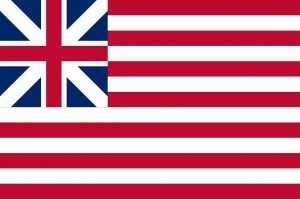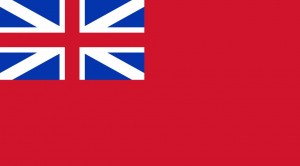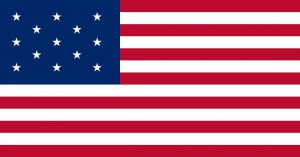Our Flag Declares that We are United
Looking at the Family of American Flags, we can see the resemblance between the United States flag and the banner we call the Grand Union flag. They both display the colors red, white and blue. They both have a field of thirteen stripes with a symbol of union in the upper hoist next to the flag pole. However, one has a look distinctly British and the other one does not.

Known today as the Grand Union Flag, this banner was our unofficial national flag in the early days of the American Revolution. The Colonists were fighting for their rights as Englishmen, but still felt allegiance to the King.
Originally known as the Continental Colors or more simply just as the Union flag, the Grand Union flag was born early in the conflict between the British Mother Country and her American Colonies. Even after the first volley of muskets sounded at Lexington and Concord, the colonists thought of themselves as English men and women who shared the same rights as their fellow subjects of the Crown who lived on British soil. These British colonists felt, at the beginning of the struggle, that they merely wanted to secure the rights that were guaranteed to all of King George’s subjects. They believed their grievance was with Parliament not with Great Britain or with their king. The Grand Union Flag reflected these feelings.
Paul Revere, when he made his famous ride to warn the countryside of troop movements, is often quoted as saying, “The British are coming!” Although he did “ride to spread the alarm”, he most certainly did not use those words as he rode through “every Middlesex village and farm, for the country folk to up and to arm.” Why not? Well, he and the “country folk” all considered themselves to be British. To say “the British are coming,” he might as well have said, “We are coming.” What would he have said? “The regulars are coming”—meaning British troops of the regular regiments sent to Boston by the British Government. Since these troops wore red uniforms, they were also called Lobster Backs or simply Red Coats. So, he could have said, “The Red Coats are coming” or “The Lobster Backs are coming.”

The Red Ensign was flown by British Merchant Shipping and furnished the pattern for Colonial militia colors. The Union Jack in the upper corner was and is an emblem of the Union of England with Scotland.
If the Grand Union is the U.S. Flag’s father, the Red Ensign is the flag’s English grandfather. The Red Ensign, traditionally flown at sea by British commercial shipping, which was and is still fondly known as the Red Duster or the Meteor Flag, is a red flag with the British Union Flag in the upper corner next to the halyards or ship’s rigging—Red Duster because of it primarily red color, and Meteor because it red field flowed from the Union Jack in its canton corner like the tail of a meteor.
When the Colonists fashioned the Grand Union flag to reflect their attitudes of 1775, they took the British Red Ensign and simply added six white stripes to the flag’s red field, which created a field of thirteen red and white stripes. Striped flags were sometimes known as “our rebellious stripes” and showed the defiance the British Colonists felt toward the “Intolerable Acts” of Parliament, but the Union Flag in the upper corner portrayed their loyalty to George III, Great Britain’s king. Since there were thirteen stripes that denoted that there were thirteen Colonies of British North America united in the fight to preserve their rights as British subjects of the King. Notice the word Union, the British Union was in the upper corner of the flag, but the American Union or thirteen stripes was displayed over the rest of the flag’s field. The Union Jack symbolized the political union of England and Scotland while the thirteen red and white stripes announced a new American political union. So, the new striped flag was referred to as a Union Flag or, often more simply, as the Continental Flag since the thirteen colonials where spread along the eastern seaboard of the North American Continent. Years after the American Revolution’s end, historians—remembering the Grand American Revolution called the striped Red Ensign the Grand Union flag and the name stuck.

A new “Union” of 13 stars replace the British Union Jack when the United Colonies declared their independence, and like a constellation rising in the evening sky, the new Union of Colonies would rise to take its place among the nations of the earth.
As time passed, the chasm between the British king and his American subjects grew wider and deeper. Finally on July 2nd in 1776, a resolution proposed by Richard Henry Lee passed in the Continental Congress declaring:
Resolved, That these United Colonies are, and of right ought to be, free and independent States, that they are absolved from all allegiance to the British Crown, and that all political connection between them and the State of Great Britain is, and ought to be, totally dissolved.
The name “United Colonies” was still symbolized by the thirteen stripes of the Grand Union flag, but the British Union Jack would be replace by a new Union, one of thirteen stars, representing a new constellation. Like a constellation rising in the nighttime sky to takes its place with the other stars in the firmament, this new constellation symbolized a new union of independent states joined together in a union rising to take its places among the nations and empires of the world.
The three flags share colors, appearance and, most importantly, the concept of political union. The idea of American union would be tested decades later in the American Civil War, and today the Union remains strong. Today we see with some newly independent nations that union, despite strong desire, is not always easy to achieve or maintain. As a nation, the United States is blessed to be able to proclaim our Latin national motto, “E pluribus unum” which translates one out of many. Our flag, it design and its history all declare that the United States is “One Nation, Indivisible.”
